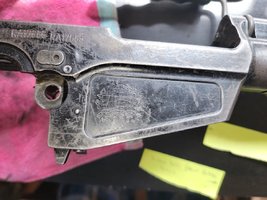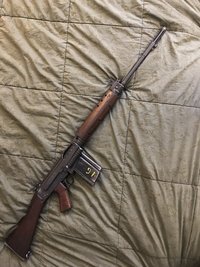History and travels of this Portuguese contract, Rhodesian used FAL
From what I have read and info I have gathered this I believe is the history and travels of this post sample FAL that I got. I was looking around on Gunbroker and saw this post sample FAL for sale for a very good price. It only had 2 pictures and they weren’t very good
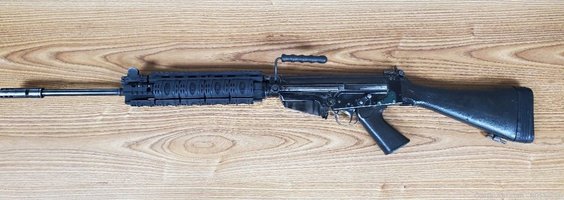

This was the description
FN FAL Full Auto .308 .
Overall length: 41.5 inches
Barrel length: 21"
UTG Picatinny Quad rail forearm
Four magazines included - Uses standard FAL mags
SN indicates this was built from an Rhodesian Army FAL imported as a kit. Exteriors shows wear, functions well, bore is bright.
Not much to go on. I contacted the seller and asked if it shoot and works good. They said yes so, I took a chance and bought the gun. The ATF was pretty quick and approved the form 3 in a few days and I had the gun about a week later.
After looking at it, it didn’t seem to me that this was a kit-built gun. I tracked back the gun 4 owners to who I believe was the importer of the FAL. I also put some pictures on some forums to see if I could gather some history on the gun. I didn’t know to much about FAL’s. I also looked online and here is what I think is the history of this gun.
The Portuguese acquired their FAL’s in 1961 designated as the m/962.
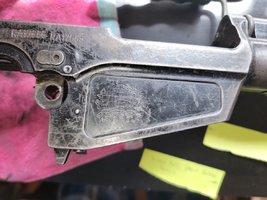
This is what it would have looked like when it was delivered to Portugal.
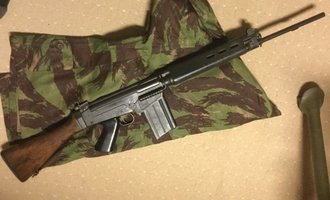
So, this gun was made between 1961-1968, you can tell this by the stampings on the gun
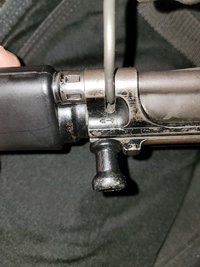
The "*M" mark indicates the name of the Belgian Controller of Proof, which Scorpion Maurice from 1959 until 1968.
The mark next to that is the Liege, Belgium proof mark, called Le Perron, used to indicate inspection or proof of breeching system.
I believe that the “C” and the # 4 in this picture indicates that the gun was made in 1964. The "C" was a Belgian proof mark for 1964.
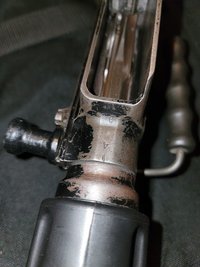
So, between 1964 and 1974 the FAL made its way with the Portuguese commandos to Africa, and they did their thing there. In April of 1974 Portugal was pretty much done with Africa. From what I have found there was an Auction of a lot of the Portuguese small arms in late 1975 and South Africa was the winner of that auction.
So, this FAL made it’s way to South Africa where it was rebuilt with a new SA barrel that was numbers matched to the original FN receiver #.
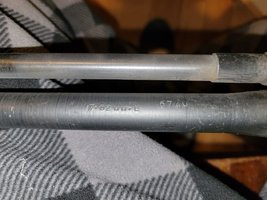
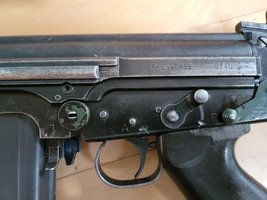
I believe it also got a South African unnumbered lower.
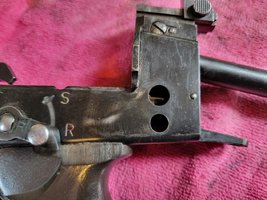
So probably somewhere between 1976-1979 it made its way to Rhodesia to fight in that war too.
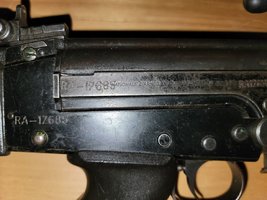
After Rhodesia became Zimbabwe, I think the FAL was refreshed up again with a used bolt, bolt carrier and some other little pieces because I have found some green paint in the trigger guard, sling swivel, break open latch and the thing that hold the pivot pin in place.
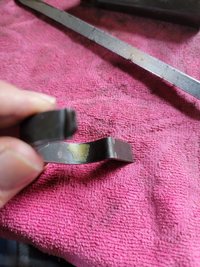
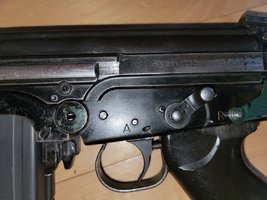
The bolt and bolt carrier where from other RA guns. The bolt carrier RA number was cruelty remarked.
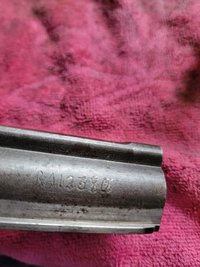
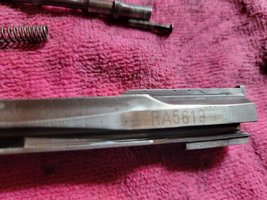
Then in probably the mid 1990’s the FAL was imported to the USA along with the Rhodesian FAL’s by Century Arms. Looks like Century turned most of them into parts kits. I emailed Century to see if they could tell me anything about this gun and their response was
" Thank you for the inquiry regarding the history of your firearm. We offer a richly diverse mix of products, unfortunately, we do not create historical profiles on firearms, nor do we employ any historians. The allure of firearm collecting includes learning the history from various open sources and creating your own history while safely using your acquisition. "
Then it was sold to Bob Bowman of Bowman Arms in I think the late 1990’s. I emailed him, and he said that he got it from Century 25ish years ago.
Then it was sold to a police officer in TX that also had his SOT in maybe 2005-2006. I talked to him on the phone, and he said that when he got it, it didn’t have a carry handle on it. He put one on and used the rifle as his duty gun. He also said that he had gotten a second FAL that was a sequential serial number to this gun. When he gave up his SOT the ATF came and took the second gun and all of his other post samples. In 2007 he sold it to a place in MN that used the gun as a rental gun. They were dropping their SOT and put the rifle on Gunbroker and that’s where I got it from. I changed out the ugly “tactical” handguard that was on the gun to a DSA one
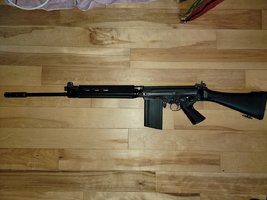
It seems like this gun has gone through quite a lot and has changed it’s look from how it came out of the factory. I wonder what parts are still with the gun that it came with from the factory with other than the receiver? I thought it was kind of neat that one could trace the history of a gun through the stampings on the gun and talking to the former owners.
From what I have read and info I have gathered this I believe is the history and travels of this post sample FAL that I got. I was looking around on Gunbroker and saw this post sample FAL for sale for a very good price. It only had 2 pictures and they weren’t very good


This was the description
FN FAL Full Auto .308 .
Overall length: 41.5 inches
Barrel length: 21"
UTG Picatinny Quad rail forearm
Four magazines included - Uses standard FAL mags
SN indicates this was built from an Rhodesian Army FAL imported as a kit. Exteriors shows wear, functions well, bore is bright.
Not much to go on. I contacted the seller and asked if it shoot and works good. They said yes so, I took a chance and bought the gun. The ATF was pretty quick and approved the form 3 in a few days and I had the gun about a week later.
After looking at it, it didn’t seem to me that this was a kit-built gun. I tracked back the gun 4 owners to who I believe was the importer of the FAL. I also put some pictures on some forums to see if I could gather some history on the gun. I didn’t know to much about FAL’s. I also looked online and here is what I think is the history of this gun.
The Portuguese acquired their FAL’s in 1961 designated as the m/962.

This is what it would have looked like when it was delivered to Portugal.

So, this gun was made between 1961-1968, you can tell this by the stampings on the gun

The "*M" mark indicates the name of the Belgian Controller of Proof, which Scorpion Maurice from 1959 until 1968.
The mark next to that is the Liege, Belgium proof mark, called Le Perron, used to indicate inspection or proof of breeching system.
I believe that the “C” and the # 4 in this picture indicates that the gun was made in 1964. The "C" was a Belgian proof mark for 1964.

So, between 1964 and 1974 the FAL made its way with the Portuguese commandos to Africa, and they did their thing there. In April of 1974 Portugal was pretty much done with Africa. From what I have found there was an Auction of a lot of the Portuguese small arms in late 1975 and South Africa was the winner of that auction.
So, this FAL made it’s way to South Africa where it was rebuilt with a new SA barrel that was numbers matched to the original FN receiver #.


I believe it also got a South African unnumbered lower.

So probably somewhere between 1976-1979 it made its way to Rhodesia to fight in that war too.

After Rhodesia became Zimbabwe, I think the FAL was refreshed up again with a used bolt, bolt carrier and some other little pieces because I have found some green paint in the trigger guard, sling swivel, break open latch and the thing that hold the pivot pin in place.


The bolt and bolt carrier where from other RA guns. The bolt carrier RA number was cruelty remarked.


Then in probably the mid 1990’s the FAL was imported to the USA along with the Rhodesian FAL’s by Century Arms. Looks like Century turned most of them into parts kits. I emailed Century to see if they could tell me anything about this gun and their response was
" Thank you for the inquiry regarding the history of your firearm. We offer a richly diverse mix of products, unfortunately, we do not create historical profiles on firearms, nor do we employ any historians. The allure of firearm collecting includes learning the history from various open sources and creating your own history while safely using your acquisition. "
Then it was sold to Bob Bowman of Bowman Arms in I think the late 1990’s. I emailed him, and he said that he got it from Century 25ish years ago.
Then it was sold to a police officer in TX that also had his SOT in maybe 2005-2006. I talked to him on the phone, and he said that when he got it, it didn’t have a carry handle on it. He put one on and used the rifle as his duty gun. He also said that he had gotten a second FAL that was a sequential serial number to this gun. When he gave up his SOT the ATF came and took the second gun and all of his other post samples. In 2007 he sold it to a place in MN that used the gun as a rental gun. They were dropping their SOT and put the rifle on Gunbroker and that’s where I got it from. I changed out the ugly “tactical” handguard that was on the gun to a DSA one

It seems like this gun has gone through quite a lot and has changed it’s look from how it came out of the factory. I wonder what parts are still with the gun that it came with from the factory with other than the receiver? I thought it was kind of neat that one could trace the history of a gun through the stampings on the gun and talking to the former owners.

